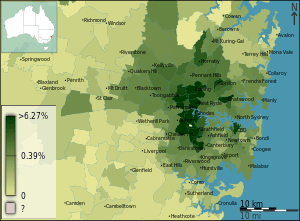Korean Australians
Korean Australians are Australian citizens who trace their Korean ancestry and identify themselves as an immigrant to or a descendant born in Australia.
| Total population | |
|---|---|
| 98,776 (by birth, 2016)[1] 123,017 (by ancestry)[1] 180,004 (according to Korean Foreign Ministry, 2017)[2] | |
| Regions with significant populations | |
| Sydney, Brisbane, Melbourne | |
| Languages | |
| Australian English, Korean | |
| Religion | |
| Christianity (chiefly Protestantism); Buddhism and non-religious minorities | |
| Related ethnic groups | |
| Korean diaspora |

History
There is some evidence of the presence of a small number of Koreans in Australia as early as 1920. While it is unclear what prompted their arrival they may have been the children of Australian Protestant missionaries who began work in Korea around 1885. A few also came to Australia between 1921 and 1941 for education.[3]
During World War II (1941-1945), an unknown number of Koreans who had been arrested in Allied countries across the Asia-Pacific Region were transported to Australia and interned alongside Japanese and Formosans for the duration of the war. Most Korean internees carried Japanese names, and were thus difficult to identify.
When the Korean War ended, some Korean women came to Australia as war brides and children as orphans, adopted by Australian families. The relaxation of immigration restrictions in the late 1960s provided the first opportunity for larger numbers of Koreans to enter Australia. In 1969, the first Korean immigrants arrived in Sydney under the Skilled Migration Program. However, there were only 468 Korean born people recorded as living in Australia at the time of the 1971 Census.[3]
In the early 1970s, about 1000 Koreans arrived each year for short-term stays (mostly as students) and around 100 arrived for permanent residence. Some of these new arrivals subsequently sponsored family members for migration. Between 1976 and 1985, around 500 Korea-born immigrants arrived each year resulting in the number of Korea-born living in Australia increasing more than sixfold between the 1976 Census (1460) and the 1986 Census (9290).[3]
From 1986 to 1991, there was a further increase in settler arrivals, with an average of about 1400 each year, many coming under the Skilled and Business migration categories. More than half of the Korea-born in Australia have arrived in the last ten years, including as students.[3]
Historical population
At the 2016 census, 123,017 persons resident in Australia identified themselves as being of Korean ancestry.[1] 98,776 persons resident in Australia had been born in South Korea. At the 2006 census, 59 persons residing in Australia had been born in North Korea.[4]
According to the 2006 census, only 38% declared holding Australian citizenship,[5] 68% had arrived in Australia in 1990 or later, and 63% reside in New South Wales. Few ethnic groups are as concentrated in one state as Koreans are in New South Wales, where 33% of Australia's population live.[6]
At the 2006 Census, 37,426 (71%) Korean-born Australian residents declared they were Christian, 3,500 (6.6%) Buddhist and 9,562 (18%) had no religious affiliation.[5] Disgruntled former members of Korean Christian churches sometimes join the handful of Korean Buddhist temples in the Sydney area.[7]
Notable people
.jpg) |  |  | _%EB%B8%94%EB%9E%99%ED%95%91%ED%81%AC(BLACKPINK)%2C_%EC%88%98%EC%A4%8D%EC%9D%80_%EB%A7%8E%EC%9D%80_%EC%86%8C%EB%85%80%EC%A7%80%EB%A7%8C_%EB%8F%8B%EB%B3%B4%EC%9D%B4%EB%8A%94_%EC%95%84%EB%A6%84%EB%8B%A4%EC%9A%B4_%EB%AF%B8%EB%AA%A8_(Golden_Disc_Awards_2019)_(3).jpg) |
- Yvette King, television presenter and entertainment journalist
- Yang Hi Choe-Wall, Koreanist and professor of Korean studies.
- Dami Im, winner of the 2013 Australian X Factor and runner-up of the 2016 Eurovision Song Contest.
- David Kang, barrister who feigned an attack on Prince Charles with a starting pistol in 1994.[8]
- Leonardo Nam, Korean Argentine actor who emigrated to Australia; born in Buenos Aires.
- Sun Park, former Hi-5 member.
- Jung Ryeo-won, actress and singer active in South Korea. Born in Seoul and raised in Brisbane.
- Peter Bell, former Australian rules football player who played for Fremantle and the North Melbourne.
- Dayen Zheng, former Hi-5 member.
- Bang Chan (Christopher Bang), leader of South Korean boy group Stray Kids.
- Felix Lee, member of South Korean boy group Stray Kids.
- Hanbyul, former member of South Korean boy group Ledapple.
- Kristine Yoon (stage name Hayana), former member of South Korean girl group EvoL.
- Barom Yu, former member of South Korean boy group C-Clown.
- Kevin Kim, former member of South Korean boy group ZE:A.
- Cho Jun Young (Young Sky), member of South Korean R&B/hip hop group One Way.
- Peter Hyun, member of South Korean R&B/hip hop group One Way.
- Hany Lee, actress (Neighbours).
- Ray Ahn, member of Australian rock bands Hard-Ons and Nunchukka Superfly
See also
References
- http://www.censusdata.abs.gov.au/census_services/getproduct/census/2016/communityprofile/036?opendocument
- 재외동포현황(2017)/Total number of overseas Koreans (2017). South Korea: Ministry of Foreign Affairs. 2017. Retrieved 28 August 2018.
- "The Korea-born Community | Department of Social Services, Australian Government". Department of Social Services, Government of Australia. 1 February 2014. Retrieved 20 April 2019.

- "Country of Birth of Person (full classification list) by Sex – Australia, 2006 Census" (XLS). Australian Bureau of Statistics. Retrieved 2 June 2008. Total count of persons: 19,855,288.
- "2006 Census Ethnic Media Package" (XLS). Australian Bureau of Statistics. 27 June 2007. Retrieved 25 March 2016.
- "3101.0 – Australian Demographic Statistics, Dec 2006 (rebased on 2006 Census results)". Australian Bureau of Statistics. 19 June 2007. Retrieved 21 July 2008. Estimated resident population, preliminary – 30 June 2006 in '000s were: NSW 6 817.2; Vic 5 128.3; Qld 4 091.5; SA 1 568.2; WA 2 059.0; Tas 489.9; NT 210.7; ACT 334.2; Australia 20 701.5
- Han, Gil-Soo; Han, Joy J. (2010). "Koreans". dictionaryofsydney.org. Retrieved 25 March 2016.
- Benns, Matthew (6 February 2005). "Man who shot at Prince Charles becomes barrister". The Age. Fairfax Press. Retrieved 24 November 2008.
